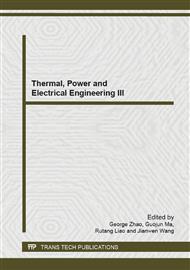[1]
Ferrara A, Lange I. Voluntary Programs to Encourage Diffusion: The Case of the Combined Heat-and-Power Partnership[J]. ENERGY JOURNAL. 2013, 35(1): 161-173.
DOI: 10.5547/01956574.35.1.9
Google Scholar
[2]
Xiaohui Z. Research on Thermo-economics Diagnostic Method for the Combined Heating Cooling and Power Plant[J]. Proceedings of the CSEE. 2009(11): 8-13.
Google Scholar
[3]
Xue-Jing Z, Shi-Jun Y, Nan J. Operational Regulation Schedule of District Heating System with Peak-Load Boiler in the Secondary Network[J]. Journal of Tianjin University(Science and Technology). 2007, 40(12): 1511-1516.
Google Scholar
[4]
Xiang G, Jun D A, Zhao F X. Analysis on Economy and Energy -efficiency of the Measurable Heating System[J]. Journal of Chongqing Jianzhu University. 2006, 28(6): 91-94.
Google Scholar
[5]
Yi J. Problems in improvement of central heating systems in China and possible solutions[J]. Journal Heating Ventilating and Airconditioning. 2006, 36(3): 37-41.
Google Scholar
[6]
Hua-Bin Z, Xiao-Xia W, Ping-Hua Z, et al. Failure rate statistics and spectrum analysis of heating network components based on an investigation[J]. Journal Heating Ventilating and Airconditioning. 2004, 34(1): 15-18.
Google Scholar
[7]
Ferreira A, Nunes M, Martins L, et al. Innovation of Decentralised Power Production: The Sustainability of Micro-Cogeneration for the Portuguese Market[J]. PROCEEDINGS OF THE 7TH EUROPEAN CONFERENCE ON INNOVATION AND ENTREPRENEURSHIP, VOLS 1 AND 2. 2012: 217-225.
Google Scholar
[8]
Rong A, Lahdelma R, Grunow M. An improved unit decommitment algorithm for combined heat and power systems[J]. EUROPEAN JOURNAL OF OPERATIONAL RESEARCH. 2009, 195(2): 552-562.
DOI: 10.1016/j.ejor.2008.02.010
Google Scholar
[9]
Pohl E, Diarra D. A method to determine primary energy savings of CHP plants considering plant-side and demand-side characteristics[J]. APPLIED ENERGY. 2014, 113(SI): 287-293.
DOI: 10.1016/j.apenergy.2013.07.038
Google Scholar
[10]
Ranjbar M R, Mohammadian M, Esmaili S. Economic analysis of hybrid system consists of fuel cell and wind based CHP system for supplying grid-parallel residential load[J]. ENERGY AND BUILDINGS. 2014, 68(A): 476-487.
DOI: 10.1016/j.enbuild.2013.10.003
Google Scholar
[11]
Gladysz P, Ziebik A. Complex analysis of the optimal coefficient of the share of cogeneration in district heating systems[J]. ENERGY. 2013, 62: 12-22.
DOI: 10.1016/j.energy.2013.04.032
Google Scholar
[12]
Coskun C, Oktay Z, Dincer I. Performance assessment of a novel hybrid district energy system[J]. APPLIED THERMAL ENGINEERING. 2012, 48: 268-274.
DOI: 10.1016/j.applthermaleng.2012.04.052
Google Scholar
[13]
Kusch W, Schmidla T, Stadler I. Consequences for district heating and natural gas grids when aiming towards 100% electricity supply with renewables[J]. ENERGY. 2012, 48(1): 153-159.
DOI: 10.1016/j.energy.2012.06.054
Google Scholar
[14]
Wu J Y, Wang J L, Li S. Multi-objective optimal operation strategy study of micro-CCHP system[J]. ENERGY. 2012, 48(1): 472-483.
DOI: 10.1016/j.energy.2012.10.013
Google Scholar


